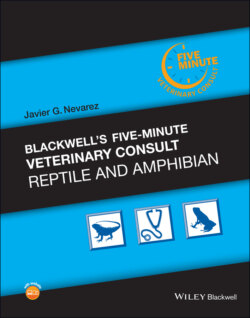Читать книгу Blackwell's Five-Minute Veterinary Consult: Reptile and Amphibian - Javier G. Nevarez - Страница 135
ОглавлениеBalantidium
BASICS
DEFINITION/OVERVIEW
Balantidium is a large ciliated protozoal organism that resides within the gastrointestinal tract. The trophozoite is elliptical in shape and ranges in size from 30–300 × 25–120 μm. It is densely covered with cilia along its surface. At the tapered front end lies the cystostome (mouth). Cysts have a thick wall, spherical in shape, and have a kidney bean‐shaped macronucleus. Balantidium testudinis is a species commonly reported in turtle species. They are typically found in herbivorous reptiles. It is debated whether these organisms are considered commensal within reptiles.
ETIOLOGY/PATHOPHYSIOLOGY
Transmission is through the fecal–oral route.
Cysts are ingested and then undergo excystation in the intestinal tract.
Trophozoites inhabit the large colon and replicate by binary fission.
Trophozoites undergo encystation in which infective cysts are formed and then excreted in feces.
Balantidium sp. are facultative parasites and only become pathogenic when other virulence factors such as hyaluronidase are present.
This then allows them to penetrate the intestinal mucosa and cause extensive hemorrhage and necrosis.
Balantidium is generally limited to the large intestinal tract.
In severe infections, the protozoal organisms migrate to the liver and cause abscessation.
SIGNALMENT/HISTORY
No age or sex predisposition
CLINICAL PRESENTATION
Diarrhea
Tenesmus
Inappetence
Weight loss
RISK FACTORS
Husbandry
Improper husbandry
Others
Immunocompromised animals with active parasitic/bacterial infections are more predisposed for the protozoan to become pathogenic.
DIAGNOSIS
DIFFERENTIAL DIAGNOSIS
Nyctotherus sp.
DIAGNOSTICS
Microscopic evaluation of fresh fecal material to visualize trophozoites and cysts.
SAF technique can be used for better visualization.
The addition of iodine will stain the contents of the cysts, making them more visible.
PATHOLOGICAL FINDINGS
Hemorrhagic necrotizing colitis
TREATMENT
APPROPRIATE HEALTH CARE
N/A
NUTRITIONAL SUPPORT
N/A
CLIENT EDUCATION/HUSBANDRY RECOMMENDATIONS
Practice proper hygiene
Wash fruits and vegetables before being fed
House infected animals separately
MEDICATIONS
DRUG(S) OF CHOICE
Metronidazole 50 mg/kg PO q24h for 7 days
Nimorazole 125 mg/kg PO q24h for 4 days
Tetracyclines 5–10 mg/kg q24h for 5–8 days
PRECAUTIONS/INTERACTIONS
N/A
FOLLOW‐UP
PATIENT MONITORING
Recheck feces on a routine basis
EXPECTED COURSE AND PROGNOSIS
Treatment should only be started if clinical disease is observed.
MISCELLANEOUS
COMMENTS
N/A
ZOONOTIC POTENTIAL
Balantidium coli is the only known species to infect humans.
SYNONYMS
N/A
ABBREVIATIONS
SAF = sodium acetate acetic acid formalin
INTERNET RESOURCES
De Bosschere H, Roels S. Balantidium sp. and Nyctotherus sp.: Two common members of the digestive‐tract flora in Mediterranean tortoises. Tortoise Trust. https://www.tortoisetrust.org/articles/balantidium.htm
Divers SJ. Parasitic Diseases of Reptiles. MSD Manual Veterinary Manual, June 2020. http://www.merckvetmanual.com/exotic‐and‐laboratory‐animals/reptiles/parasitic‐diseases‐of‐reptiles
Suggested Reading
1 Hnizdo J, Pantchev N., eds. Protozoa (digestive tract). In: Medical Care of Turtles and Tortoises: Diagnosis, Surgery, Pathology, Parasitology. Frankfurt, Germany: Edition Chimaira; 2011:194–195
2 Jacobson ER. Parasites and parasitic diseases of reptiles. In: Jacobson ER, ed. Infectious Diseases and Pathology of Reptiles: Color Atlas and Text. Boca Raton, FL: CRC Press; 2007:571–666.
3 Rataj AV, Lindtner‐Knific R, Vlahovic K, et al. Parasites in pet reptiles. Acta Vet Scand 2011; 53(1):33.
Author Elsburgh O. Clarke III, DVM, DACZM
